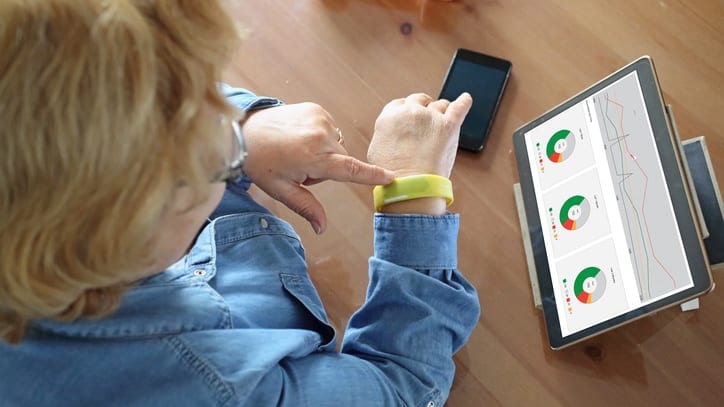Wellness Platforms Provide Flexibility, Raise Data-Privacy Concerns
Help workers ease into digital platforms by keeping data collection simple

As wellness programs become more interactive, online platforms are pulling data from employees' fitness trackers and storing it on personal sites so employees can manage their activities and gauge health improvements.
But the technology raises concerns among some participants that their data isn't secure and others might have access to it.
Tracking Fitness Activities
Wellness-platform developers have been partnering with health insurers to integrate data from wellness programs with the employees' health plans. For example:
- In April, PreferredOne, a Minneapolis-based health insurer, announced a partnership with Wellbeats to offer on-demand, virtual fitness classes, available online and on smartphone apps, to its fully insured employer groups. PreferredOne launched an in-house pilot of the program for its 300-plus employees in March. Shelley Markve, senior health promotion specialist at PreferredOne, said that, within two weeks of rolling it out, about 40 percent of the company's employees had created accounts on the fitness platform, and 70 percent had done so by mid-June. "It's been a huge success; we haven't heard any negative remarks at all," Markve said.
- In May, San Mateo, Calif.-based Human API partnered with wellness technology vendor Complete Wellness Solutions to offer comprehensive, bring-your-own-device integration to API's wellness platform. Complete Wellness CEO Linda Passmore said the partnership is intended to give users the most-convenient platforms possible: "If someone needs to track their diet, and if they are using a program they love, why make them change? They can continue using the program that they're familiar with."
[SHRM members-only toolkit: Designing and Managing Wellness Programs]
Ensuring Flexibility
The combination of wellness devices and data-storage platforms, however, can present challenges, said Anthony Knierim, co-founder of the Chicago-based activity platforms Stridekick and MoveSpring.
Wellness platforms "can turn employees off if they are not given flexibility in how their data is collected and if they think that data is being used beyond a given activity's purpose," he noted.
Both Knierim and Passmore said their technologies allow people to delete personal data from a platform while retaining an aggregate record of participation, as is necessary if incentives such as gift cards or premium discounts are earned by participating in these programs.
"We don't need to force people into the platform every time they want to track [an activity]," Knierim said. "They can decide if they want to share that data with the program."
Pursuing Data Integration
Jeanette Diamond, wellness and staff development coordinator at Dickinson College in Carlisle, Pa., would like to see connections between employees' biometrics and their participation in wellness programs such as her college's "10K-a-day" step challenge.
"I am the only one, at this moment, looking at the data collected," said Diamond, who created her own online spreadsheets to record data from employees' fitness trackers.
She noted that the college encourages participants to take free biometric screenings, such as for high cholesterol and prediabetes indicators, throughout the year and offers free blood-pressure screenings monthly, but it does not track any biometric improvements related to participation in the wellness programs. Diamond would like to have participants do biometric checks before and after the step challenge, which she would prefer to run for longer than the current six-week duration, "to show positive aggregate results to the community."
She added, "We have not quite arrived at this point in program planning yet, but I am hopeful we will get there in the near future."
MoveSpring's Knierim said keeping programs and data collection simple, relatable and flexible is still the best way to ease into digital platforms.
"People understand steps, distance and active minutes. That's the most common standardized data across any activity device, and you don't even need a wearable [tracker]; you can use your phone to track this data."
Fitness Apps
Craig Ulrich, senior sales director at PreferredOne, said corporate wellness technology and programs are just now entering the consumer-apps phase. Wellbeats' range of online fitness classes, for participants with activity levels ranging from virtual beginners to workout warriors, is an example of the flexibility the market will demand, he said.
"When you go on vacation, you may go online to find lodging, schedule a flight and grab a ride," Ulrich said. "Then you might look on your phone to see what kind of nearby restaurants deliver and use another app to get your food." Similarly, wellness apps need to "meet people where they are now."
Ulrich continued, "If you want to get somebody off the couch, getting them to go to a brick-and-mortar [health club] is kind of daunting." Wellness apps can be "a much easier way to get them into the fitness lifestyle."
Greg Goth is a freelance health and technology writer based in Oakville, Conn.
Related SHRM Articles:
Employers Broaden Well-Being Programs, SHRM Online, September 2019
Viewpoint: 3 Questions to Ask Wellness Program Providers, SHRM Online, July 2019
Next-Generation Incentives: Interactive Engagement Promotes Healthy Behavior, SHRM Online, June 2017
An organization run by AI is not a futuristic concept. Such technology is already a part of many workplaces and will continue to shape the labor market and HR. Here's how employers and employees can successfully manage generative AI and other AI-powered systems.



